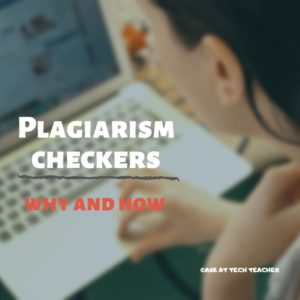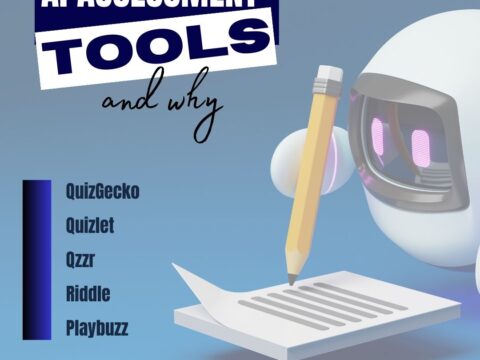Ask a Tech Teacher contributor Serhii Tkachecnko, CEO at Unicheck, shares his thoughts on how educators can teach students about the benefits of plagiarism checking.
***
 Students experience an array of emotions toward education: from excitement to boredom. But when it comes to plagiarism checking, most students feel hostile. Many misconceptions circle around plagiarism checkers, but in reality, plagiarism checkers improve the cooperation, communication, and collaboration between educators and students. They are meant to help students and educators succeed.
Students experience an array of emotions toward education: from excitement to boredom. But when it comes to plagiarism checking, most students feel hostile. Many misconceptions circle around plagiarism checkers, but in reality, plagiarism checkers improve the cooperation, communication, and collaboration between educators and students. They are meant to help students and educators succeed.
Instead of being intimidated by plagiarism checking, why not educate students on its benefits? Here’s what you should explain to your students about plagiarism checking.
Using Plagiarism Checkers is Necessary
Before people accept something, they have to understand why they need it. Unfortunately, many students fail to understand the necessity of plagiarism checkers and treat them as a biased accusation of academic dishonesty. It will take some effort to change this mindset and help your students stop stressing about being checked.
It’s a pity that some students fail to get their A+ because of the improperly cited sources. Regardless of whether the assignment lacked a citation, the citation method was wrong, or the student didn’t cite the correct source, a plagiarism checker could have fixed that. However, it’s an even bigger shame that the will to cheat overrules the will to express oneself. Plagiarism checkers can help students become better writers, express unique ideas, and stand out. On top of that, when all assignments equally go through a plagiarism check, the competition becomes fair again.
Educators should start explaining to students that a plagiarism checker is their friend as early as possible. In this way, by the time they reach college, students will already know these checkers are not used to punish them, but rather to improve their writing skills and the quality of education, both higher and K-12.
Plagiarism Checkers Work According to Certain Principles
Not knowing how something works may leave you frustrated, and the mechanics the plagiarism checkers keep under the hood may seem tricky. How exactly does this piece of software know if the work is original or plagiarised? And how should students know if they can trust a checker? Is the report it gives all that accurate?
Complaints vary. Some learners claim it’s difficult to interpret the results given by the system. Others say that the system flags their own words. And then there are cases of “false positives.” If students don’t check their works for plagiarism before turning them in, they may fall victim to unintentional plagiarism, a phenomenon that occurs when proper procedures for citing are not followed. They can also miss the instances of self-plagiarism, which is an act of non-intentional repetition of one’s previous work.
All this chaos can be avoided if you go through the concerns your students have regarding being checked and explain to them the principles of how these checkers work.
It’s Important to Choose the Right Plagiarism Checker
Once the dust has settled, and students understand how plagiarism checkers work, it’s important to select the right tool. Take a look at Unicheck, an effective and user-friendly plagiarism detection and prevention platform. The system checks papers automatically at a speed of 20 seconds per page. Unicheck is committed to the principles of academic integrity and is on a mission to create community-driven software that enhances education.
Unicheck’s database is updated regularly, so the source uploaded just ten minutes ago will still be recognized by the system. Additionally, Unicheck is integrated with major LMS systems, including Canvas, Google Classroom, Brightspace, and Moodle. Unicheck is safe, easy-to-install, and comes with 24/7/365 support that replies in less than a minute.
Modern Plagiarism Checkers Identify More than Copy-Pasting
It’s easy for the most basic plagiarism checkers to identify copy-pasting. However, students are far more inventive than that, and checkers need to follow. Unicheck can boast of Modifind, an integrated text modification detector, and EMMA, an AI-based authorship verification system. Modifind discovers the changes made to increase originality scores, including character replacements, white characters, special symbols, and even multiple document layers.
Some students turn to essay mills when they are stressed out or run out of time to complete an assignment. Primitive plagiarism checkers can’t indicate contract cheating, but Unicheck’s EMMA identifies the author based on basic linguistic characteristics (lexical variations and word distribution). The AI that powers EMMA only needs to analyze three works to determine if the author of the work is the one who had submitted it.
Conclusion
It’s time to reframe the conversation about academic integrity away from punitive measures to open communication and authentic improvement. Teach your students about plagiarism checking so that they would treat it as a helpful tool, not a means to penalize them. Plagiarism checkers for teachers and students like Unicheck are meant to make the education process better thanks to their accuracy, user-friendliness, and continuous innovations.
More on plagiarism
Plagiarism: What it is and how to identify it
Quick Search for Plagiarized Images
Teaching Digital Rights and Responsibilities
Jacqui Murray has been teaching K-18 technology for 30 years. She is the editor/author of over a hundred tech ed resources including a K-12 technology curriculum, K-8 keyboard curriculum, K-8 Digital Citizenship curriculum. She is an adjunct professor in tech ed, Master Teacher, webmaster for four blogs, an Amazon Vine Voice, CSTA presentation reviewer, freelance journalist on tech ed topics, contributor to NEA Today, and author of the tech thrillers, To Hunt a Sub and Twenty-four Days. You can find her resources at Structured Learning.




































